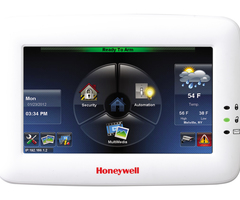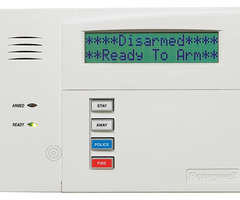How Do Alarm Keypads Work?
Alarm keypads work by sending commands to an alarm system and displaying status information from the system. Zone faults and other information are shown on the display. Arming commands are entered at the keypad and sent to the panel for processing. Keypads act as both inputs and outputs.

There are many reasons why a user might have an alarm keypad for their security system. If they have a hardwired panel, they will need to have a keypad for operating the system and for performing panel programming. For these systems, a user will want a keypad that is capable of performing installer-level programming. They may also want a keypad that doubles as a wireless receiver so that they can use wireless sensors with their alarm system. Both wired and wireless alarm keypads exist. Some keypads can even be operated using a touchscreen. However, a user must make sure that the keypad they purchase is compatible with their alarm system.
A user may also get an alarm keypad so that they can have a second on-site access point for controlling their system. This can be particularly useful for those with multiple entry points or very large properties. By using multiple keypads, a user will not need to walk across their entire property to control their alarm system. And by placing a keypad by their front door and a separate one by their back door, they can conveniently arm and disarm their system regardless of which entryway they use.
It should be mentioned that alarm keypads should not be confused with alarm control panels. The control panel represents the "brains" of the alarm system, and a keypad is merely used for operating the system. If a keypad were to ever be deactivated or destroyed, the system as a whole would continue to operate. In fact, some users install keypads simply for the purpose of keeping their actual system safe in the event of a break-in. The intruder will likely see the keypad and think it's the actual system. Even if they destroy the keypad, the system will remain safe and capable of signaling.
A wireless all-in-one (AIO) system will essentially double as a keypad. For these systems, basic operation and programming can be completed directly from the panel itself. Many users who own a wireless AIO system won't bother to purchase a separate alarm keypad, since all operation can be conducted from the panel. They may also use an interactive service like Total Connect 2.0 or Alarm.com to control their system.
But for a hardwired system like a Honeywell VISTA, an alarm keypad is required. Without a keypad, a user will have no way of programming, or seeing the status of, their panel. A keypad is also necessary for arming and disarming the panel. The keypad will usually be placed in an easily accessible location, while the wired panel itself will generally be hidden somewhere else.
Did you find this answer useful?
We offer alarm monitoring as low as $10 / month
Click Here to Learn MoreRelated Products






Related Videos
Related Categories
- Alarm Keypads
- Wired Alarm Keypads
- Wireless Touchscreen Keypads
- Touchscreen Keypads
- Wireless Alarm Keypads
- Wired Touchscreen Keypads
- Answered





